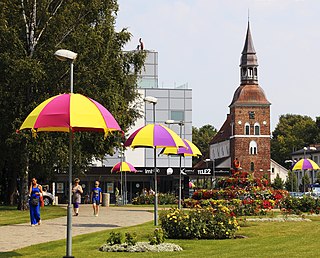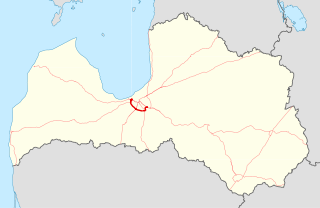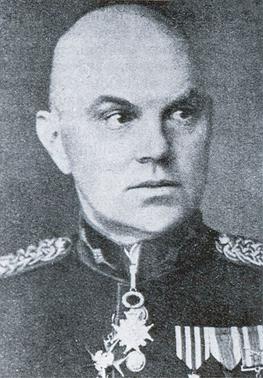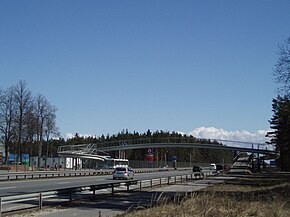Transport in Lithuania relies mainly on road and rail networks.

Valmiera is the largest city of the historical Vidzeme region, Latvia, with a total area of 19.35 square kilometres. As of 2002, Valmiera had a population of 27,323, and in 2020 – 24 879. It is a state city the seat of Valmiera Municipality.

The Riga Radio and TV Tower in Riga, Latvia is the tallest tower in the European Union. It was built between 1979 and 1989 with funding from the central government of the Soviet Union. Its highest point reaches 368.5 metres (1,209 ft), which makes it the third tallest tower in Europe and the 15th tallest self-supporting tower in the world.

The Coat of arms of the Republic of Latvia was officially adopted by the Constitutional Assembly of Latvia on 15 June 1921, and entered official use starting on 19 August 1921. It was created using new national symbols, as well as elements of the coats of arms of Polish and Swedish Livonia and of the Duchy of Courland and Semigallia. Thus, the coat of arms combines symbols of Latvian national statehood, as well as symbols of its historical regions. The Latvian national coat of arms was designed by Latvian artists Vilhelms Krūmiņš and Rihards Zariņš.

Saulkrasti is a town in Latvia on the east coast of the Gulf of Riga and the capital of the Saulkrasti municipality. Made up of a number of historic fishing settlements, the town stretches for some 17 km from the Inčupe river in the south to the village of Skulte in the north. The town itself spans across 4.8 square kilometres (1.9 sq mi) and includes an additional 42 square kilometres (16 sq mi) of fields and forests.

JSC Latvian Railway was established on 2 September 1991 and is seen as the successor of the Latvian Railway Board which was established on 5 August 1919.

The A1 highway (Riga - Border of Estonia ), also known as the Tallinn highway is a national road in Latvia, which connects the Riga bypass with the Estonian border at Ainaži. The highway continues in Estonia as highway 4 until Tallinn. A1 is fully covered in asphalt, and its length in Latvia is 101,7 km. The highway is part of European route E67 and, starting from Lilaste until the Estonian border, does not move further than 6 km from the coast of the Baltic sea.

The A4 is a national road in Latvia and part of the Riga ring road, connecting Baltezers to Saulkalne.

The A5 is a national road in Latvia which is part beltway around Riga, connecting Salaspils to Babīte. The road is also known as Riga bypass. The road is part of European route E67, European route E77 and Latvian TEN-T road network. The length of A5 is 41 kilometer. Currently A5 has 1x1 lanes until interchange with A9 then it turns to 2x2 all the way until Babīte. Most of the traffic on A5 is made up by trucks. A5 crosses river Daugava on Riga HES, and the A5 part on the HES has been reconstructed in 2010/2011. Another part of A5 between A8 and A9 was reconstructed in 2011. There are plans to build a new bridge over Daugava opposite to the end of A4, in further future. Current speed limit is 90 km/h. The average AADT of A5 in 2016 was 12 482 cars per day.

The A7 is a national road in Latvia connecting Riga to the Lithuanian border (Grenctāle), through Bauska. The road is also known in Latvia as the Bauska Highway. The A7 is part of European route E67 and the European TEN-T road network. The road becomes the Lithuanian A10 at the border. The length of the A7 in Latvian territory is 86 kilometers. Currently the A7 has 2x2 lanes only within the territory of Riga, other parts have 1x2 lanes. The current speed limit is 90 km/h except within municipalities. In period of 2005 - 2006, the A7 was reconstructed from the 25th until the 43rd kilometer and from the 67th until the 85th kilometer. A 2 kilometer stretch of the road was reconstructed in Iecava, and reconstruction of another 15 kilometer long stretch was finished in 2012. Construction of the Ķekava bypass is planned to begin in 2017. The bypass will be built to expressway or motorway standards. The average traffic (AADT) on the A7 during 2016 was 14,599 cars per day.

The A8 is a national road in Latvia connecting Riga to Lithuanian border (Meitene), through Jelgava, also known as Jelgava highway in Latvia. The road is part of European route E77 and Latvian TEN-T road network. After the border, the road turns into Lithuanian A12. The length of A8 in Latvian territory is 76 kilometers. Currently A8 has 2x2 lanes until Jelgava bypass, other parts have 1x1 or 2x1 lanes. The current speed limit is 100 km/h. Plans to reconstruct A8 in to a motorway have been many. First, in 2004, then in 2010, but they never started due to financial reasons. In the recent years A8 has been reconstructed in many stretches. The average AADT on A8 in 2015 was 13,711 cars per day.

Motorways in Serbia are called auto-put, a name which simply means car-road. Roads that are motorways are categorized as state roads of IA category and are marked with one-digit numbers. Motorways in Serbia have three lanes in each direction, signs are white-on-green, and the normal speed limit is 130 km/h (81 mph). They are maintained and operated by the national road operator company JP "Putevi Srbije".

Ropaži Municipality is a municipality in Vidzeme, Latvia. The municipality was formed in 2005 with the reorganization of Ropaži parish. The administrative centre is Ropaži. The population in 2020 was 6,835.

Žanis Bahs was a Latvian general. He fought in World War I and later in the Latvian War of Independence, where he commanded a division in the Republic of Latvia. After the Soviet occupation of Latvia in 1940 Bahs was arrested and shot by Soviet authorities.

Põhimaantee 4 is a 192-kilometre-long north-south national main road in Estonia. The route follows the same path as the European route E67, also known as the Via Baltica. The highway starts in Tallinn. From there the main cities passed are Saue, Märjamaa and Pärnu. The highway ends in Ikla at the Latvian border.
Events in the year 2015 in Latvia.
Riia-Pihkva maantee is a highway in south-eastern Estonia. It is a short section of the E77 in Estonia, serving little other purpose, with just 21.4 kilometres of length. The highway begins on the Latvian border and ends at the Russian border crossing at Luhamaa.

Brīvības iela is the central street of Riga, the capital of Latvia. It is more than 12 km long, going through all of Riga from the historical centre to the outskirts.
Valdis Celms is a Latvian artist, graphic designer and neopagan leader. He known for his kinetic art and is one of the leaders of the Baltic neopagan organization Latvijas Dievtuŗu sadraudze.

Livonia is one of the five multi-member constituencies of the Saeima, the national legislature of Latvia. The constituency was established in 1922 when the Saeima was established following Latvia's independence from the Soviet Union. It consists of the city of Jūrmala and municipalities of Ādaži, Alūksne, Cēsis, Gulbene, Ķekava, Limbaži, Madona, Mārupe, Ogre, Olaine, Ropaži, Salaspils, Saulkrasti, Sigulda, Smiltene, Valka, Valmiera and Varakļāni in the region of Livonia. The constituency currently elects 26 of the 100 members of the Saeima using the open party-list proportional representation electoral system. At the 2022 parliamentary election it had 396,278 registered electors.
























